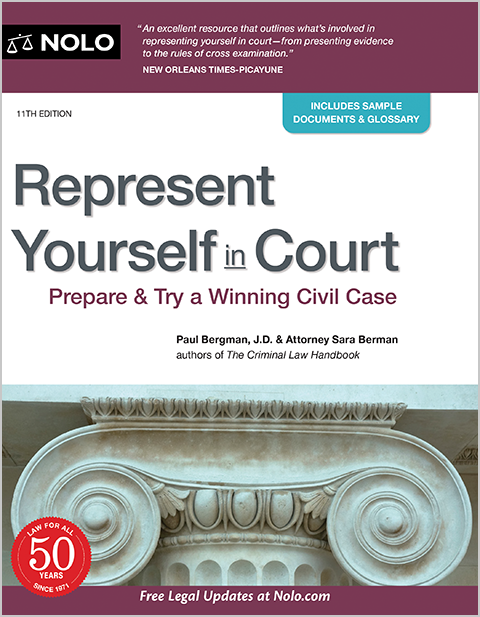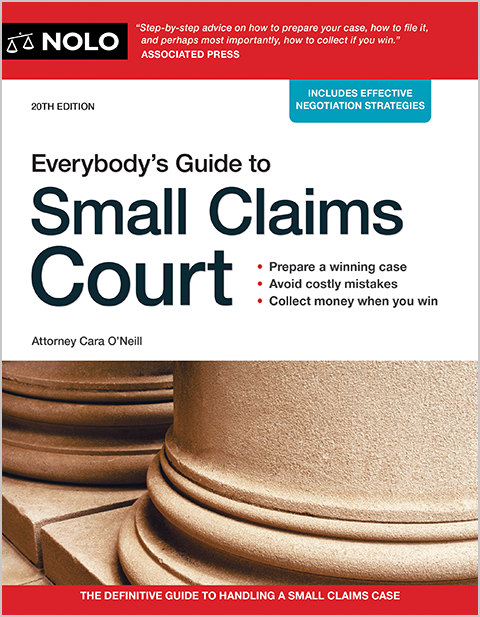Learn about filing a small claims case in Alaska District Court.
Filing a claim in the Alaska District Court, the court handling small claims matters in Alaska, can be a straightforward and inexpensive way to settle a dispute. Although the procedures are more relaxed than in traditional courts, you still must follow the rules to prevail.
Below are answers to some common questions about the Alaska small claims process. You'll learn about preparing and presenting your case, collecting a money judgment, and appealing a small claims decision. You'll also find links to additional small claims articles and resources.
How Does Alaska Small Claims Court Work?
A small claims case starts by filing a claim in the small claims docket of District Court and serving a copy of the claim on the "defendant," the person or company you're suing. You must present evidence supporting your case at trial. The defendant can present a defense and file a claim against you if you owe the defendant money.
After hearing each side's argument and evaluating the evidence, the judge will issue a money judgment to the person proving they're entitled to an award. Receiving a money judgment is very powerful because it allows a creditor to collect using property liens, wage garnishments, bank account levies, and property seizures.
What's the Small Claims Court Dollar Limit in Alaska District Court?
You can ask for up to $10,000 in a small claims action in Alaska District Court. Plaintiffs with claims exceeding the limit can use small claims court if they're willing to accept the $10,000 cap. Otherwise, they must file in a higher court. (Alaska Stat. § 22.15.040 (2025).)
Can a Landlord Bring an Eviction Lawsuit in an Alaska Small Claims Court?
Evictions aren't heard as small claims in Alaska District Court. (Alaska District Court Rules of Civil Procedure, Rule 8 (2025).)
However, the small claims division is an excellent forum for other types of cases typically brought in small claims courts, such as property damage cases and breach of contract disputes.
Which Alaska District Court Should I File My Small Claims Action in?
Alaska has many District Courts, but you can't always pick the most convenient location. You must choose the proper court location, or venue. Otherwise, the defendant can ask the court to transfer or dismiss your action.
In Alaska, you can file in the court:
- nearest to the defendant's residence or place of employment
- in the district in which the injury or property damage occurred
- in the district where the defendant does business, or
- in a place that "will not cause unnecessary expense or inconvenience" for the defendant.
(Alaska District Court Rules of Civil Procedure, Rule 12 (2025).)
Go to the Alaska Department of Commerce, Community, and Economic Development corporations database to search for company information. You might have other options, depending on your case. Most courts post venue rules on the court website.
How Much Time Do I Have to File a Case in Small Claims Court in Alaska?
You don't have an unlimited amount of time to file a lawsuit. You'll have to bring it within the statute of limitations period for the case type. But pinning down how much time you have to file isn't always as simple as reading the statute of limitations.
The time can stop and restart depending on various circumstances, and figuring out when it expires can be challenging. The process is known as "tolling" the statute of limitations, and it happens when a plaintiff or defendant is unavailable for a lawsuit. For instance, a personal injury limitation period typically won't begin running on a minor's injury until the child reaches 18 years of age and can sue without the help of a guardian. Learn more about calculating the statute of limitations and whether it's too late to sue.
Can an Attorney Represent a Small Claims Claimant in Alaska District Court?
Yes, any party in a small claims case can have a lawyer represent them in court. (Alaska District Court Rules of Civil Procedure, Rule 15 (2025).)
Because small claims court is more relaxed and easier to navigate than higher courts, most people are comfortable pursuing claims "in pro per" or without counsel.
Does the Defendant Need to Answer the Small Claims Complaint?
Yes. The defendant must file an answer within 20 days of service of the complaint to avoid an automatic loss and default judgment. (Alaska District Court Rules of Civil Procedure, Rules 10, 13, 17 (2025).)
Learn more about what happens if you get sued in small claims court.
Will I Have a Judge or Jury Trial in Small Claims Court in Alaska?
A judge will hear your case. Alaska doesn't allow jury trials in small claims cases. (Alaska District Court Rules of Civil Procedure, Rule 16 (2025).)
Find out what to expect at the small claims trial.
How to Prepare and Present an Alaska District or Magistrate Court Case
You'll want to explain what happened and present evidence supporting your version of the events and the amount of money lost.
What Do I Need to Prove in My Small Claims Case?
It will depend on the type of case. In most instances, you'll need to prove that the person you're suing harmed you and the amount of money it will take to right the situation. Research the "elements" of your case type to determine exactly what you must prove.
Tip. One of the most important things people forget to do is prove how much they're out of pocket. For instance, you'll likely provide medical bills if you were injured and repair estimates if you suffered property damage. Make sure you can prove how much it will take to fix the problem.
What Type of Evidence Should I Present in Small Claims Court?
One of the benefits of small claims court is that the rules of evidence are relaxed. Even though the judge won't require you to follow the exacting rules of evidence litigants are held to in higher courts, you'll still need to prove your case by submitting solid evidence.
For instance, if you're suing someone who didn't comply with a written contract, you'll need copies of the contract and any correspondence exchanged. You might also want to present photos of shoddy work or damaged property.
If someone witnessed an event, bring them in. You might also need expert testimony to establish the defendant caused the problem if it isn't something that can be inferred. For instance, only a medical professional can testify about the cause of an illness or injury, and you'd need a mechanic to verify most automotive repairs. Check with the court to see if you can provide a statement made under oath if the person is unavailable or charges too much for in-person testimony.
Learn about gathering evidence in support of your small claims case.
How Should I Organize My Small Claims Presentation?
After providing the judge with a short case description, you'll likely present the facts chronologically. If you're afraid you'll forget something or are worried you'll ramble on, write out your presentation and read it when it's your turn. However, you'll likely make a better impression if you speak naturally, using a bullet point list for reference when needed. Either way, practicing beforehand is the key to a polished presentation.
Also, it's best to cover each point concisely yet fully, with as little emotion as possible. You'll also want to avoid jumping in if the other side says something incorrect. Instead, make a note and address it when it is your turn to speak.
What Happens After Presenting an Alaska Small Claims Case
The court might announce the winner immediately after the trial, but it's more likely that you'll find out who prevailed by mail. Your next steps will depend on whether you win or lose.
Will the Court Collect My Judgment for Me?
Generally, no. You'll likely be responsible for all collection efforts. However, some small claims courts offer installment plans the losing party can use to pay the judgment (and some courts will order an installment plan).
Before pursuing a small claims court case, you'll want to evaluate whether the defendant has assets you can seize after winning the case. A debtor with nothing you can take is called "judgment proof," and pursuing an action won't make sense unless the debtor acquires property and income in the future.
Learn more about determining whether you can collect before suing in small claims court.
Can State Exemption Laws Stop Me From Seizing the Defendant's Property?
Yes. Every state allows debtors to protect essential property from creditors, such as household goods, a percentage of income, and some equity in a car and home, although the specific property protected varies greatly. You'll find these protections in your state's exemption statutes. In most states, the same exemptions protect assets from creditors in and outside bankruptcy.
Learn more about why you shouldn't sue unless you can collect the judgment.
Can I Appeal an Alaska District Court Decision?
Yes, you can appeal the decision if you lose a case filed against you. Under Alaska law, you must file the appeal within 30 days from the date shown in the clerk's certificate of distribution of judgment. (Alaska District Court Rules of Civil Procedure, Rule 18; Alaska Rules of Appellate Procedure, Rules 204, 217 (2025).)
You must comply with this rule and all other rules or you'll lose your appeal rights. If you're confused about the process or how to find the date used to calculate the filing deadline, talk with the court clerk or a local attorney.
More Information About Alaska Small Claims Court
Most courts include filing instructions on the court website. For additional resources, try the Alaska Court System's small claims self-help page. There you'll find small claims forms and the Alaska Courts' Small Claims Handbook.
You can also view Alaska statutory law online on the Alaska State Legislature's website. See Alaska Stat. §§ 22.15.040 and 22.15.050. You'll find the court rules on the Alaska Court System Legal Resources page. See, especially, Alaska District Court Rules of Civil Procedure, Rules 8 to 22, and Alaska Rules of Appellate Procedure, Rules 204 and 217.
For detailed help with case filing, court strategy, and collecting a money judgment, see Everybody's Guide to Small Claims Court by Attorney Cara O'Neill (Nolo). And Nolo's small claims homepage is an excellent place to start if you have other questions.
After reviewing all of those resources, you might decide that you'd like to consult an attorney. An experienced local lawyer can walk you through your options and help you decide on a path forward.



